I’ve kept my promise pretty well, at least the one about trying to read more adult books this year. It’s true that I am on a bit of a YA tear right now after finishing the 3rd book in The Agency series, The Traitor in the Tunnel, which I loved, but now I want to read more steampunk/historical fiction spy books. I started on Jepp Who Defied the Stars by Katherine Marsh, but 130 pages in and I was only about half interested in what would happen next. So today I started Empire in Ruins, the third book in The Hunchback Assignments series, which is looking pretty good. I’m also listening to The True Meaning of Smekday, which I picked up last week on a whim because a fellow Youth Services Librarian liked it. It’s surprisingly hilarious and witty for a children/YA book, a welcome change from my last selection. I’m on a bit of a break from the Caldecott Challenge, so I don’t get completely burned out on the experience, but hope to be reading more soon. As always, I rate things from 1 – 5 stars, one being the lowest and 5 being the highest.
Children
The Happy Egg by Ruth Krauss, illustrated by Crockett Johnson
This was a recommended book for toddlers, so I figured I would check it out. I had no idea that the author and the illustrator (both famous in their own rights) were married to each other. I was not a fan of the story, finding it overly repetitive (more than I felt it needed to be even if it is good to be that way to this age group). Even my son was bored with it. Recommended for ages 1-4, 1 star.
Duck, Duck, Moose by Dave Horowitz
I picked this one up because I love moose and ducks, and I thought my son might like it. Moose loves pancakes and wants to get some with his friend Bear but he is hibernating. So he asks Duck and Other Duck, but they are going south for the winter. So he tags along for the road trip. He has so much fun in Florida that when he gets back to the North, he recreates it. Recommended for ages 1-6, 2 stars.
Maisy Goes to the Library by Lucy Cousins
I bought this for my son at the library book sale because I love Lucy Cousins’ bright and colorful artwork. In this book, Maisy enjoys going to the library so she can find a nice quiet place to read a book. This time it is a book about fish. She likes doing other things at the library, including going to storytime, using the computer, and using the resources available there. My only gripe with the story is that it should’ve ended when she checked out her book, instead of dragging the story along for a couple extra pages. Recommended for ages 1-6, 3 stars.
Happy Pig Day! by Mo Willems
Piggie is excited because it is her favorite day of the year, it’s Happy Pig Day! This is a day for celebrating pig culture with partying, dancing, singing, food and games. My son’s favorite part was when I got to say “Happy Pig Day” in pig language continuously. Gerald feels left out because he is not a pig, but soon finds out that you don’t have to be; you just have to like pigs. The end pages are cute, especially the ones in the back of the book. Recommended for ages 1-6, 3 stars.
Just Say “Please!” by Sarah Wilson
I am trying to teach my son to say please instead of grabbing food, so this book seemed just right for that as he likes Spongebob. It doesn’t quite work though. Mr. Krabs has no manners and his daughter Pearl is embarrassed to have him come for Parent’s Day at her school. Spongebob and Squidward decide to take matters into their own hands and make up a story telling him that a queen is coming to visit and he must be on his best behavior and they teach him good manners. When it comes time for Parent’s Day, Pearl is even more embarrassed by his good manners that she tells him that she wants him back the way he was before. Recommended for ages 1-6, 2 stars.
Bear Has a Story to Tell by Philip C. Stead, Illustrated by Erin E. Stead
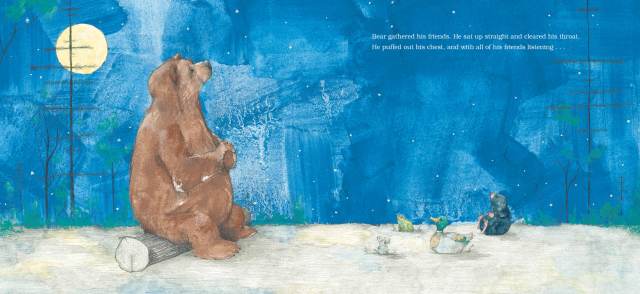
I had enjoyed Sick Day for Amos McGee their 2011 Caldecott winning book, so I figured I would give this book a try when I saw it on a Goodreads booklist. I wasn’t a huge fan of the story; thought it was a bit boring to be honest. But it did teach kids about being patient and helping others without requiring thanks, which is important for all kids to learn. Bear wants to tell his friends a story, but each of the forest animals (mouse, frog, duck and mole) are getting ready for winter and have no time to hear it. After spring comes, Bear sits down to tell them and then forgets, but his friends help him out. I loved the watercolor illustrations that made Bear look so sleepy and fluffy, just ready for hibernation with his friends. My favorite painting was where Bear sits down with his friends to finally tell his story. Recommended for ages 3-7, 3 stars.
I Know a Rhino by Charles Fuge
Another recommended book for toddlers, this one was actually good. I thought it was an adorable story about a toddler/preschool girl who goes on a picnic with a bear, takes a bath with a giraffe, looks after a dragon with a cold and other adventures. She is able to do with her stuffed animals and a lot of imagination. The illustrations are great and the text is short, bold type and rhyming. Highly recommended for ages 1-6, 4 stars.
Chu’s Day by Neil Gaiman, illustrated by Adam Rex
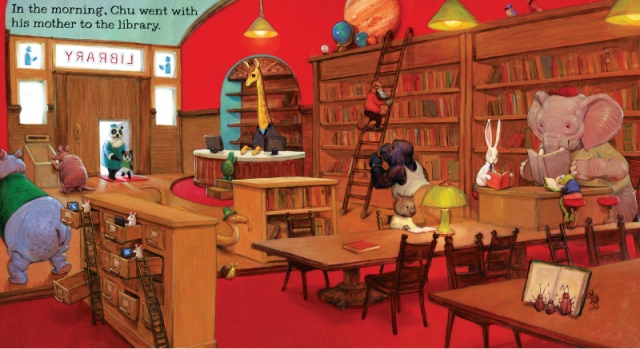
I will totally admit that I picked this up for me and not my son because I love Neil Gaiman. That being said, I thought the story was too short. Though as another Goodreads reviewer has said, I can totally hear the author narrating it in my head, which is pretty cool. Thankfully the illustrations were awesome, which more than made up for it. It’s the details that get me, like in the library where the mice are at the computer in the card catalog drawers or the eagle and tapir eating together in the diner.
When Chu the little panda sneezes, bad things happen. His parents take him places where he could sneeze, like the library with its dusty books and the diner with too much pepper. It is only after they take him to the circus with all the other animals that he does finally sneeze and there are pretty catastrophic results. Recommended for ages 1-6, 4 stars.
We’re Going on a Bear Hunt by Michael Rosen, illustrated by Helen Oxenbury
Another toddler book recommendation, this one was an excellent choice. Based on a traditional song, this book is retold by Michael Rosen (author of Michael Rosen’s Sad Book, an excellent book on grief/depression for children) and illustrated by the fabulous baby book writer/illustrator Helen Oxenbury. The pages vary between black and white for the main repeating text and color for the sound effect text, like “Swishy swashy” sounds for going through tall grass. My son enjoyed this book, especially when he got to make the “Hoooo Woooo” of the snowstorm. I liked how the dad and four kids finally find the bear, then spend the rest of the book running away from it until they all tumble into bed at home. For more information on the book, check out this Guardian article. Highly recommended for ages 1-7, 5 stars.
Louie by Ezra Jack Keats
I picked up this freebie book at the deGrummond Collection’s (at the University of Southern Mississippi) special exhibit on Ezra Jack Keats, which I saw about 3 years ago, but never got around to reading it. I picked it up to read to my son the other day, but I must say it is not one of my favorites of his work. Susie and Roberto are putting on a puppet show with a mouse puppet and baby puppet named Gussie. Louie, a younger child in the audience, just falls in love with Gussie and can’t resist talking to her during the performance. Before this show, Louie is a very quiet child who hardly ever speaks. After the show, the Susie and Roberto decide to give Gussie to Louie, since he was so attached to it. While I didn’t like the story so much, the painted illustrations were lovely, especially the dream sequence. Recommended for ages 3-7, 3 stars.
Sora and the Cloud written and illustrated by Felicia Hoshino, translation by Akiko Hisa
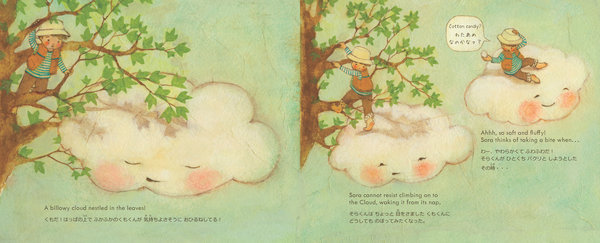
I picked this one up because it was on a best picture books of 2012 list, plus the cover and premise just sounded adorable. And like the Goodreads description, it is a bit Miyazaki-ish in story. The book is bilingual, English/Japanese and the translations to the text are in the back. Sora is a toddler/preschool Japanese boy who loves to climb, and one day he climbs a tree. When he gets to the top, he discovers a sleeping cloud and he climbs on top of it. The Cloud takes him way up high to see the top of a building construction site, a theme park, a kite festival, an airplane and fireworks. The Cloud and Sora get sleepy and start dreaming. Eventually they drift back to the tree and Sora races to tell his sister about his adventures. The author was also the illustrator and did these lovely illustrations done on watercolor paper using ink, watercolor paint and pencils, markers, acrylic, and tissue paper collage. As a result, the illustrations are all lovely and soft, just like the Cloud. Highly recommended for ages 3-7, 5 stars.
Squid and Octopus are Friends For Always by Tao Nyeu
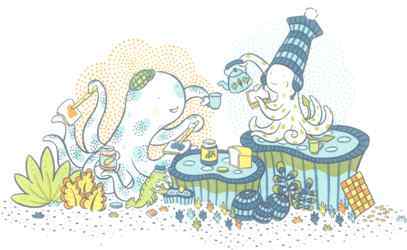
I absolutely adored this picture book! It was like someone took my love of cephalopods and decided to create a version of Arnold Lobel’s Frog and Toad books but with Squid and Octopus as the main characters, and with better, more creative illustrations. My only gripe is that it was a bit long for my son, perhaps they could’ve divided into two books with two stories each instead of four. The first story was about a quarrel that Squid has with Octopus about whether they should wear mittens or socks. In the end, they decide to share and have a pot of tea and cake. The second story was about a crazy long dream that Squid has where he had superpowers, and afterwards he feels sad about it. Octopus tries to cheer him up by telling him about all the awesome things he does. The third story was about an object (cowboy boot) that floats down to Octopus, which he thinks is a hat, but everybody tells him it is something different. That is, until Squid shows up with a matching hat. The four story was about Squid getting a fortune cookie and Octopus telling Squid about all the different kinds of fortunes it could be. My favorite parts were the fabulous whimsical illustrations, that really made the story. Highly recommended for ages 3-7, 5 stars.
Pssst! by Adam Rex
I decided to pick up a few Adam Rex illustrated books after reading Chu’s Day, which he illustrated with Neil Gaiman writing the book, and loving the illustrations. Most of his books are for a slightly older child than my son, but I had fun reading it to him nonetheless. Most of the reason I enjoyed this book were the quirky illustrations (a lot of play on words such as “Camel-lot”, but also a batman next to the Bat Cave and a Narwhale snowglobe), though I thought the story was only okay. The book is about a young girl who goes to the zoo, but keeps getting stopped by animals asking her to buy things for them with a bag of coins they collected from the fountain. She thinks they are just buying them for their habitats, but they actually have an ulterior motive. Recommended for ages 4-8, 3 stars.
Chloe and the Lion by Mac Barnett, illustrated by Adam Rex
I loved Extra Yarn so I was excited to find that Mac Barnett and Adam Rex collaborated on several other books as well. I enjoyed this book because the author, Mac Barnett and the illustrator, Adam Rex, both end up as characters in the story. My only gripe is that it was a little long, even for older kids, who I think would lose interest in the book halfway through.
The book tells us the story of Chloe who collects loose change everywhere so that she can use the money to go on the merry-go-round. One day, she collects so many coins and rides all day, so that she has to cut through a forest at night and ends up getting lost. She hears some noises and a lion is supposed to jump out at her, but Adam decides to insert a dragon because it is cooler (it is) and then proceeds to get into an argument with Mac. At the end of the argument, Mac tries to hire another artist Hank, whose lion immediately eats Adam, and then gets fired. Mac tries to be both illustrator and author, but he sucks at drawing. So Chloe ends up going to several characters from other stories (who have made their way into the book somehow) to ask for help to get Adam out of the lion, but no one does so she convinces the lion to cough him up (which he does). The story sort-of ends there, but Chloe demands they make a better ending so the lion ends up coughing up enough money for everyone to go on a merry-go-round ride. Recommended for ages 4-8, 3 1/2 stars.
The Dirty Cowboy by Amy Timberlake, illustrated by Adam Rex
This was another book I picked up because I love Adam Rex’s illustrations. Thankfully the story and illustrations in this book were awesome. It is so much fun to do in a southern accent (not saying all cowboys are from the South, but it works in this case). The book is about a cowboy that lives on his own with a horse and dog (really a wolf). He decides one day to take a bath. It’s the detailed drawing that kill me in the book, from the “cowboy’s hair housing thirty-two fleas and a small gray spider” and the tumbleweed that gets stuck in the back of his chaps. The cowboy goes to soap up and rinse off in the river and tells the dog that no one but him can touch the clothes. Then the hilarity ensues: from the carefully blurred out or obscured genitalia before jumping in the water, to the dog not budging from the now-clean cowboy’s clothes because he doesn’t smell right, and a fight breaks out between the dog and the naked cowboy trying to get his clothes back. Only after they’ve been tussling in the mud and the clothes have all been ripped apart does the dog realize that this is his owner. So the cowboy, horse and dog walk back home together. Highly recommended for ages 5-12, 5 stars.
The Bee-Man of Orn by Frank R. Stockton, illustrated by P.J. Lynch
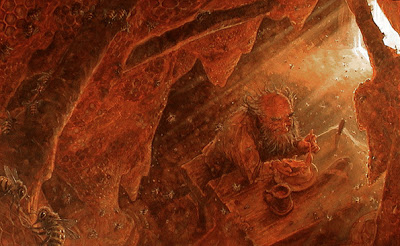
I picked up this book on a whim because I loved the cover art, while I was looking for books for my son. This one is a bit too long to hold his attention. The story, I’ll admit, was unusual but the painted watercolor and gouache illustrations by two-time Kate Greenaway medalist P.J. Lynch were fabulous! The story was originally published in 1883, but this version of it was done in 1887. The book came with a 15 1/2 minute DVD about the illustrator, which goes into detail about how he first reads the manuscript (the text of the book) several times before deciding which scenes to illustrate, which he then does in storyboard format. At first the drawings are very basic, but as he goes through drafts, they become more detailed. It was a fascinating look into the creative process of the artist.
The Bee-Man is a happy old man who lives by himself with thousands of bees and his house has become a giant hive. He lives off the honey and the bees live happily with him. One day, a Junior Sorcerer appears and tells him that he can change him back to whatever he was before, but he must find out what that is first. So the Bee-man sets off with his mini-hive to discover himself. At first he finds a palace, and thinks himself a king, but the actual ruler literally kicked him out of the kingdom. After a couple more days of traveling, he finds a great black mountain full of caves full of dragons and other evil things. On the way in, he meets a “Languid Youth, who wants to tone up his energies,” but is too lazy to do so, so they go in together. The Bee-Man sees a vicious dragon about to devour a baby, and saves the baby. He and the Languid Youth run for their lives from the dragon and eventually the Bee-Man finds the baby’s mother and returns him. The Languid Youth is revitalized and goes to inform the Junior Sorcerer that the Bee-Man wishes to be turned back into a baby, and he is raised by the grateful rescued baby’s mother. Years later, the Junior Sorcerer becomes a Senior one and finds the Bee-Man all grown up and living in his beehive house once again. For a cool resource on the book’s discussions, check out this website. Recommended for ages 7-12, 4 stars.
Young Adult
A Spy in the House (The Agency #1) by Y.S. Lee
I really enjoyed this book, which has been on to-read list for ages and I finally picked up a copy at the library book sale this past weekend. It was a very fascinating story which reminded me of L.A. Meyer’s Bloody Jack books and Gail Carriger’s Parisol Protectorate series. The author definitely knows her Victorian history and culture (which makes sense as she got her PhD in Victorian literature and culture).
Mary Quinn is on trial for thievery and is about to hanged, when she is saved by a mysterious woman who take her to Miss Scrimshaw’s Academy for Girls. There she is given an education and taught good manners. After she has been there awhile, they give her the opportunity to become a secret agent, working for The Agency, a team of female spies that work for the government. She accepts and is trained as an agent, and sent on her first assignment. Mary is trying to find out what is happening to art cargo sent from India, which has been mysteriously disappearing. Her cover is as a lady’s companion to the daughter of the merchant thought responsible. Will she be able to uncover the truth about the stolen artifacts? Is everyone in the household who they seem to be or do they all have secret agendas? To find out, check out this great introduction to The Agency series. Recommended for ages 12+, 5 stars.
The Body at the Tower (The Agency #2) by Y.S. Lee
I honestly couldn’t wait to pick up the second and third book in the series after reading the first. I devoured this one, the story being just as great as the first. Mary Quinn is now a full-fledged agent in the Agency, the all-female spy ring secretly run at Miss Scrimshaw’s School for Girls. Her next assignment requires her to go undercover as a young boy on the building site for St. Stephen’s Tower, which is to hold Big Ben, which is now 25 years behind schedule. There was a mysterious death of one of the builders on the site, Mr. Wick, and Mary has been sent as Mark Quinn to find out who is really behind it. James Easton, her almost love interest from the previous book, returns from a building project in India, where he almost died of malarial fever. He is assigned by the first commissioner to investigate the building site and the safety measures taken for the official inquest into Mr Wick’s death. So Mary (or in this case) Mark is forced to work with James on a daily basis, each instantly recognizing each other. Mary makes up a story about researching a book about the poor working boys, so as not to blow her cover with the Agency. There is a shady reporter named Octavius Jones working for the local scandal sheet, who keeps trying to pump her for information. Is this death a cover-up for something bigger? Or was Wick’s death just a suicide? Will Mary and James ever figure out their relationship? To find out, check out this awesome second book in The Agency series. Recommended for ages 12+, 5 stars.
The Traitor in the Tunnel (The Agency #3) by Y.S. Lee
I thought the mystery part of the story wasn’t as good in this volume (seemed shorter and James wasn’t involved as much) as the previous two books in the series. However, she did include a fairly interesting storyline about my favorite Prince of Wales Bertie (my favorite future king Edward VII)! It was pretty easy to see early on how the father element of the story was going to play out, but there were a few surprises. The romance, in this book, was weird because James wasn’t in the story as much, but the ending more than made up for the rest of the story.
Book 3 of The Agency series has Mary pretending to be a parlor maid in Queen Victoria’s household at Buckingham palace, as she is trying to uncover some minor thefts of personal knick-knacks of the royal family. While she is there, she is uncovering two other mysteries, which she has stumbled upon. First, the Crown Prince was accidentally involved in the death of a nobleman by a Lascar in an opium den, which they went into after a night on the the town and getting incredibly drunk. Mary wants to know if the Lascar (what the English call the Chinese sailors that live in London) was really to blame or if it was the young nobleman’s fault? Mary notices the lady-in-waiting to the queen open a secret door in the kitchen which leads to the sewer, so she discusses with James what it could be for and they go to investigate. Whilst in the sewer together, they meet a fleeing stranger who injures James. Who is the stranger and what does he want with the closed passage leading to the palace? To find out those three mysteries and more about James and Mary’s growing relationship, check this awesome third book in the series! Highly recommended for ages 12+, 5 stars.
The Miseducation of Cameron Post by Emily M. Danforth
I picked up this book after loving Aristotle and Dante Discover the Secrets of the Universe (check out the review from my last review post, and wanting to read something off the William C. Morris Award list – debut books honored as the best of the year in YA literature (this won a 2013 honor from there). And I thought the title was eye-catching.
The story is about Cameron, a twelve year old girl living in a small town in Montana in the late 80s – early 90s, who knows she likes girls after kissing her best friend. She comes to this realization the day her parents die in a car crash. Over the next couple of years, she uses movies, pot, drinking and hanging out with the guys to self-medicate herself, while she tries to discover who she really is and what she wants. Cameron continues to follow her desires with two or three other girls, until she is betrayed by the girl she falls in love with. Her evangelical pastor and conservative aunt decide that she needs to be sent to a gay rehabilitation center called God’s Promise to be “fixed”. Will she survive the center and be able to figure out who she truly is?
It was a really fascinating book, which made me think of my childhood. The main difference being that the main character is about four years older than me, but we grew up about the same time in small towns in different states. I thought the scenes with the dollhouse and her obsessive need to decorate it with all her trinkets and things she stole was unusual but made sense. I wanted to share what some other reviewers said about the book. Malinda Lo from NPR said: “While it’s being published as a young adult novel, Cameron Post is certainly also meant for adult readers. The historical specificity makes it especially meaningful for those of us who came of age before the Internet. [This book is] especially for teens growing up today in communities that don’t accept them for who they are. But it is also a skillfully and beautifully written story that does what the best books do: It shows us ourselves in the lives of others.” Catherine R. Smyka of The Stranger wrote this about the book: “Danforth inspects the raw parts of acceptance, healing, and moving forward. In Cam’s head, Danforth has written the perfect young-adult stream of consciousness. Her descriptions are teenage-awkward and feel organic and uncensored.” Kirkus Reviews had this to say about the story: “Even when events take a dark and gut-punchingly inevitable turn, the novel remains at its heart a story of survival and of carving out space even in a world that wants one’s annihilation. Rich with detail and emotion, a sophisticated read for teens and adults alike.” Due to the graphic language and content, especially at the end of the book, I would highly recommend this for ages 14+, 5 stars.
Monstrous Beauty by Elizabeth Fama, narrated by Katherine Kellgren
Honestly I wasn’t sure what to expect when I picked up this 2013 Odyssey Honor Award winner, other than it was narrated by the fabulous Katherine Kellgren who I adore. It was definitely a different kind of book, in that it switched back and forth in time between 1873 and present day Plymouth with the added bonus of an intergenerational romance and mermaids. Normally I tend to stay away from fairy or mermaid books (they tend to be either awful and/or too girly), but this one and Laini Taylor’s books are an exception to those rules. I really enjoyed the book, helped along by the fantastic narration. I also liked the interview of the author by the Ms. Kellgren at the end of the book, from which you can glimpse the creative process of the writer and narrator.
The book is narrated by a 17 year old girl named Hester Goodwin, who lives with her dad, stepmom and half-brother Sam. Hester has been very careful never to fall in love due to her maternal family history, in which all the women in her family seem to die after falling in love and giving birth to their first child, which is always a daughter. One night, she meets a mysterious man named Ezra and feels herself completely drawn to him, despite her vow never to fall in love. He tries to help her with her family history, though he has his own troubles involving a woman named Syrenka. Along the way, she rediscovers an old friend from her childhood and finds a new one. Will she ever figure out why the women in her family are cursed? Will she be able to be happy with Ezra? Just who is Syrenka and how is she linked to everyone? To find out, check out this well-done novel. Due to some graphic content, recommended for ages 15+, 5 stars.
Adult
Gilgamesh: A New English Version by Stephen Mitchell, narrated by George Guidall
Gilgamesh was one of those classics that I had always intended on getting around to reading, but never really picked it up. It is, after all, the world’s first hero story and so important to our worldwide literary culture. So when I saw this version (it is called a version instead of translation because the author is not a translator), I decided to give it a try. I’ve not read the poem before, but I know from his mentioning of the other translations, that his is quite different and modern from the original Akkadian/Sumerian version. I thought the language was very good and masterfully done, though the repetitiveness of the text sometimes got a bit boring. I was a bit shocked by the graphic descriptions that he used to describe the sex and violence, considering that this poem is 3500 years old. This audiobook collection includes the author’s version of the poem as well as a comprehensive essay written about the poem. I personally liked the essay, as it helped better explain the poem, whose ideas were difficult to grasp at times.
The basic story is about the Sumerian King Gilgamesh of Uruk and his self-discovery. It starts off talking about the wild man Enkidu, who is created by the gods as a foil to Gilgamesh, thought of as a greedy and selfish tyrant. A young trapper sees Enkidu helping the local fauna and asks the king how to get rid of him. The king enlists the help of Shamhat, a priestess of Ishtar (goddess of love, fertility and war) who acts as temple prostitute and seduces Enkidu and brings him back to Uruk. Enkidu and Gilgamesh eventually become best friends (though there are definitely some homoerotic overtones to their friendship). Gilgamesh decides that in order to achieve everlasting fame, he must kill the guardian of the cedar forest, a vicious monster named Humbaba. The conquences of this action affect the rest of the story. After Humbaba is killed, they head back to Uruk, where Gilgamesh is propositioned by the goddess Ishtar. He proceeds to verbally bash and abuse her, ultimately refusing her advances. Her retaliation is to get her father Anu (the father of the gods) to send the Bull of Heaven to kill Gilgamesh, but he and Enkidu kill the bull instead. As punishment, Enkidu is killed and Gilgamesh is overcome with grief. He decides that he must go see the only immortal human Utnapishtim and figure out how to beat death. Utnapishtim tells him the story of the flood and how he was granted immortality as a result of it. He also tells him of a plant that will make him immortal, but Gilgamesh foolishly loses it and there ends the poem. 4 stars.
The Anatomist by Federico Andahazi
I originally picked up this book after getting on a Renaissance kick, plus I liked that it was part gender history/religion/sexuality. It was a very odd book. I definitely varied between thinking it was genius and total crap. Some things may be lost in translation, but it was frustrating how the author left so many loose ends.
The story is based off the real-life character of Mateo Realdo (Renaldo in the book) Colombo, who is apparently not related to the famous Columbus, but did discover his own “America”. Mateo discovered the “Amor Veneris” which means “the love or sweetness of Venus,” aka the clitoris. In historical fact, however who actually discovered it is debatable. In the book, he is an anatomy professor at the University of Padua, and learns how the body functions by primarily dissecting animal bodies. He falls in love with a Venetian whore named Mona Sofia and is determined to win her affections somehow. So he starts experimenting with herbs and fellatio with local whores, which get him into some trouble with the dean of the university, who already doesn’t like him. Mateo is a well-renown doctor and goes to Florence to help cure a very rich noblewoman named Ines de Torremolinos. It is with her that he first “discovers” the Amor Veneris and writes about it in his book. This is what really pisses off the dean, who calls the Inquisition to burn him at the stake. I did find it a bit amusing that Mateo tries to explain himself in a 19-part oration about souls, kinetic energy, and the secret of women. He is only saved by a summons from Pope Paul III, who sees him as a possible heretic but an even better doctor. Renaissance medical practices are crazy, that’s all I will say about that part of the book. He manages to live a little while longer thanks to saving the Pope, and eventually goes to see his Mona Sofia, who is dying of syphilis. One of the weirdest parts of the book is when Ines de Torremolinos receives the letter that Mateo has sent her during his trial and proceeds to perform genital mutilation, take herself and her daughters back to Spain where she buys a bunch of brothels (where she makes the women do the same to themselves), makes a ton of money and then is burned at the stake with her children. 3 stars.
In My Father’s Country by Saima Wahab
I picked this up in the new book section because it sounded intriguing. It reminded me a lot of my best friend, although not an Afghani, she is caught as the author was between two worlds and trying to make sense of her place in them. You know how sometimes you read an autobiography is so dense you can’t read it? Well this book read like a fiction novel, plus the subject matter was something I didn’t know much about, so I just flew through it.
The author was born a part of the Pashtun ethnic group in Afghanistan. Her father was captured (and most likely killed) by the Soviets during their invasion of the country, and her and her family had to flee into Pakistan. Saima was treated differently from most Pashtun girls by her father and later her grandfather, and so had different experiences to other girls in her culture. She traveled to the States as a teen and grew up there. After college, Saima decided that she needed to go back to her father’s country and signed up with the US Army as an interpreter and later as a researcher, spending five years in total. I thought it was interesting because it explained her cultural background and relationships, something I am familiar with because of my friend (therefore a lot of her decisions made sense to me). I was also intrigued by the history with the Soviets and the Americans’ original reason for going into Afghanistan. I will admit that I really didn’t know anything about the war there other than very basic facts, so this book cleared up a lot of history for me. Highly recommmended, 5 stars.
Gordon Ramsay’s Sunday Lunch: 25 Simple Menus to Pamper Family and Friends by Gordon Ramsay
Despite his foul-mouthness on TV, I think he is an awesome chef with really great recipes. He’s probably my favorite British chef, though my hubby would probably rate Jamie Oliver higher. He created this cookbook after being appalled that not enough Britons sat down as a family for a meal and ate too many frozen meals. Most of the recipes are pretty easy and straightforward, but as is the case with most British cookbooks, some of the ingredients would be really hard to find out here. I did manage to find about eight recipes that I wanted to try. My English husband assures me that mixing jello, fruit and ice cream with biscuits and chocolate does make for an excellent dessert, so I will have to give the Knickerbocker Glory a try. Other recipes I would like to try are the Artichoke, Asparagus, Tomato and Onion Tart, Red Cabbage Slaw, Gordon’s Apple Pudding, his Red Wine Gravy, Ginger & Port Marinated Lamb Skewers (though this recipe will probably be very infrequent given the cost of lamb in the States), and Paella. 3 stars.
Home is a Roof Over a Pig: An American Family’s Journey in China by Aminta Arrington
I picked up this up from the travel/foreign history section on a whim, after loving my last choice from there (In My Father’s Country by Saima Wahab). The book turned out to be a personal family memoir, with snippets of Chinese language, culture and history, as well as the family adventures traveling through China and living there for 7 years (as of 2012 when the book was published). The title comes from the actual Chinese character for Home, which literally translates as “a roof over a pig”. The Arrington family, with three children under the age of six, decided to move to China after adopting a girl from China four years before, to show her more about her culture. They move to the Shandong province and the city of Ta’in. At first they are only known as the “foreigners,” but after spending four years there and building relationships, they are considered part of the community. They did move eventually to Beijing as the children got older and their apartment was too small.
Each chapter discusses a particular Chinese character, usually something about its etymology from traditional to modern characters, and then how it applied to a particular episode in Arrington’s life. An example would be the chapter on language, which means “the words of myself,” in which the author discusses how her adopted Chinese daughter Grace did better in learning the Chinese language, despite the fact that she had never really been previously interested in words or books. I liked when Arrington told her students that “learning a foreign language is not academic, it is social.” I definitely believe this to be true, especially in relation to taking Italian as a foreign language at university. I found it much easier to grasp the concept of Italian after having to use it in everyday life and conversation versus trying to read it in a book and I’ve found the same to be the case with internationals that I helped in conversational English. Highly recommended, 5 stars.
Marbles: Mania, Depression, Michelangelo and Me by Ellen Forney
I’ve been wanting to read this for awhile because lot of people have been talking about it, plus it just looked fascinating. A lot of my friends in high school and college were bipolar, so I do have some experience with it. The graphic novel is about the author/illustrator Ellen Forney being diagnosed bipolar shortly before her 30th birthday and how she dealt with it, via meds, journals, drawing, yoga and pot. I liked how, at the end of the book, she really delved into how creative people are frequently more likely to be bipolar and how many famous artists, poets and other writers were actually either bipolar or just depressed (including Michelangelo, Van Gogh, Sylvia Plath, and Emily Dickinson). It was interesting how she tackled being bipolar and there were a lot of things about the diagnosis that I had never thought about. As someone who has taken anti-depressants, I know how much it can numb you, so I understand how the author could be worried about how medications would make you lose your creativity. While they can help you, I don’t think medication is the right path for all of those with mental health problems. However, I would recommend some sort of medication mix for those with the disorder as I’ve seen those without it and it is not a pretty picture, nor can they function well. I would recommend this book to anyone with the disorder or those with family/friends that have it, or really anyone interested in reading a really good and insightful memoir. 4 stars.
Michelangelo and the Pope’s Ceiling by Ross King
Normally I like a really in-depth look at art history, but this time it just annoyed me. This book was supposed to be an in-between book but it was taking so long to finish, I had to completely stop it about halfway through so I could listen to the other book I had on hold (Monstrous Beauty). While it is interesting to hear about how an artist actually completes a fresco, I found it boring that they spent so much time going over it. I found the personal history of Michelangelo, his relationship with Pope Julius II (Giuliano del Rovere) and the description of the Sistine Chapel itself much more fascinating. I knew of the Pope because I had seen the sculptures that Michelangelo completed for his unfinished tomb, which was originally supposed to go in St Peter’s Basilica but ended up in San Pietro in Vincoli (St Peter in Chains). The church’s name come from the relic of St Peter, who was imprisoned with the chains in Jerusalem. But also I knew him from my obsession with the Borgias, as he was Alexander VI’s most hated rival, who became pope after Rodrigo Borgia died. It was interesting to know that Michelangelo did not paint the ceiling of his own free will, but was rather forced into it by rival Donato Bramante (the architect whose plans were later executed by Michelangelo when the project to re-build St Peter’s Basilica was finally completed). Michelangelo’s work became the gold standard for thousands of artists to copy through the centuries. He also did not paint the ceiling on his back, as Charlton Heston would have you believe in the movie version of “The Agony and the Ecstasy”. I had no idea that he hated Raphael so much either. I learned enough about Raphael’s work in the Vatican apartments for me to want to research him next, as I know the basics about his work, but not much about the artist himself. 4 stars.


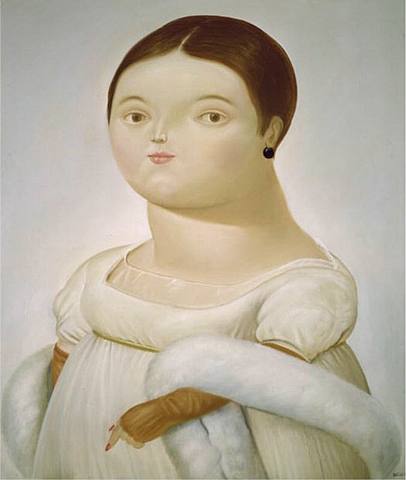
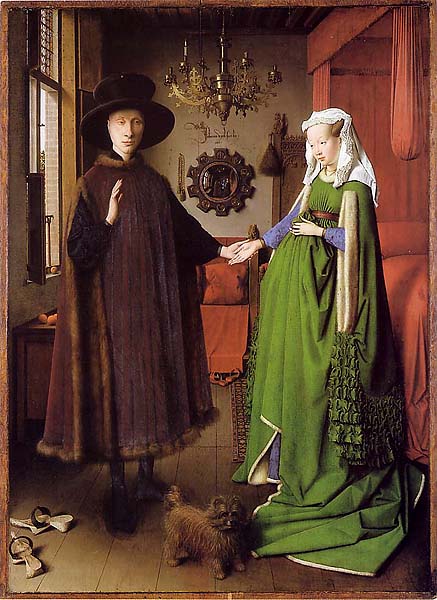
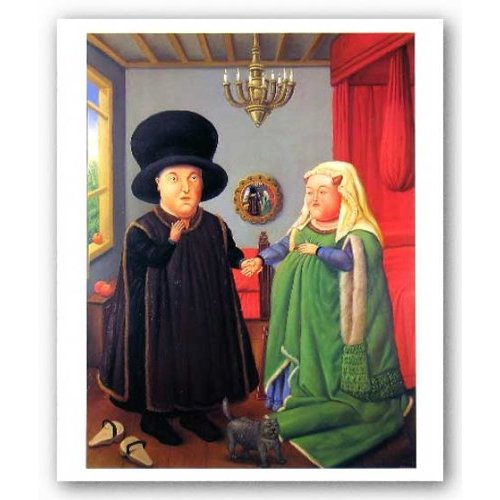











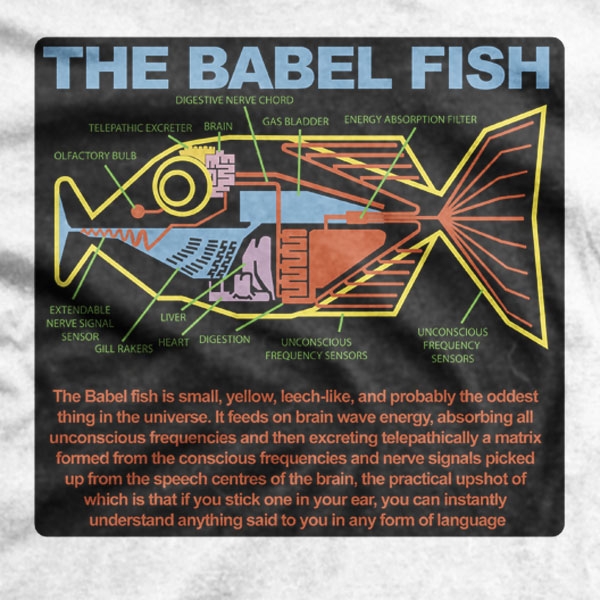

You must be logged in to post a comment.